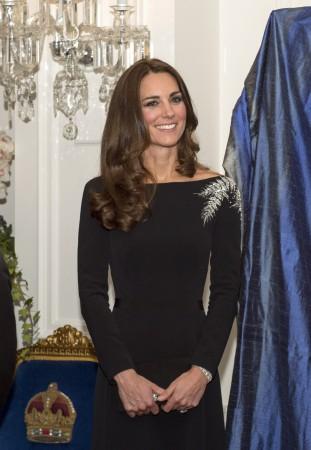
A new research has revealed that Kate Middleton was destined to be part of the royal family, given that she shares a common ancestor with the late Queen Mother.
Michael Reed, an art historian from Australia discovered it while researching the famous Blakiston-Bowes Cabinet.
The unique piece of furniture is now located at the New York MET Museum. Prince William and Princess Kate, who are currently in the United States for a brief tour, are scheduled to see the cabinet during their official visit, Daily Mail reports.
The Cabinet was built in Newcastle around 1700 to celebrate the wedding between two of County Durham's biggest families of that time – the Blakistons and the Bowes-Lyons. The Cabinet that helped a great deal in the discovery has the family crests of both the familes on its doors.
The common ancestor that Princess Kate Middleton and the Queen Mother share is Sir William Blakiston of Gibside Hall, near Gateshead. Sir William's great granddaughter, Elizabeth, married into the Bowes-Lyon family. Queen Mother, also known as Elizabeth Bowes-Lyon, is the descendant of Elizabeth.
According to the Northern Echo, Reed found that ancestors of Middleton were the Blakiston Baronets and the Baronets of Conyers of Hordern. They were the wealthiest landowners in Northern England and their intention of marrying into the Bowes-Lyon family was to share each other's huge estates at Gibside that were very rich in coal. The Queen Mother last visited the family estate in 1968.
"It makes sense that Kate wore the Queen Mother's tiara when she married Prince William - both women share a great deal, Durham ancestry, the vast Gibside Estate and the same famous cabinet," said Reed.
It has been learnt that Kate's direct ancestor, Sir Thomas Blakiston Conyers, had also attended the funeral of his cousin Mary Bowes, the Countess of Strathmore and Kinghorne. Mary Bowes was great-great-great-grandmother of the Queen Mother and was considered to be the wealthiest woman in England in 1800.
"It does not surprise me at all. When Kate married William, I hoped that she would take County Durham from where the Queen Mother left it because each member of the Royal family used to have their own area and when the Queen Mother was alive she was always here," says Weardale Royalist Anita Atkinson.


!['Had denied Housefull franchise as they wanted me to wear a bikini': Tia Bajpai on turning down bold scripts [Exclusive] 'Had denied Housefull franchise as they wanted me to wear a bikini': Tia Bajpai on turning down bold scripts [Exclusive]](https://data1.ibtimes.co.in/en/full/806605/had-denied-housefull-franchise-they-wanted-me-wear-bikini-tia-bajpai-turning-down-bold.png?w=220&h=135&l=50&t=40)











!['Had denied Housefull franchise as they wanted me to wear a bikini': Tia Bajpai on turning down bold scripts [Exclusive]](https://data1.ibtimes.co.in/en/full/806605/had-denied-housefull-franchise-they-wanted-me-wear-bikini-tia-bajpai-turning-down-bold.png?w=220&h=135)


![Nayanthara and Dhanush ignore each other as they attend wedding amid feud over Nayanthara's Netflix documentary row [Watch]](https://data1.ibtimes.co.in/en/full/806599/nayanthara-dhanush-ignore-each-other-they-attend-wedding-amid-feud-over-nayantharas-netflix.jpg?w=220&h=135)